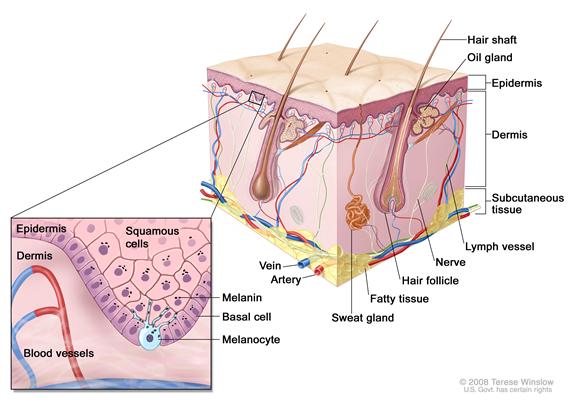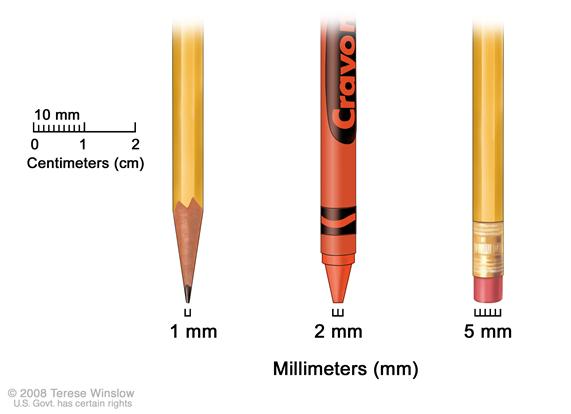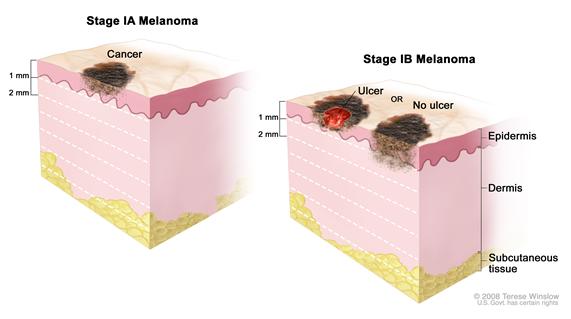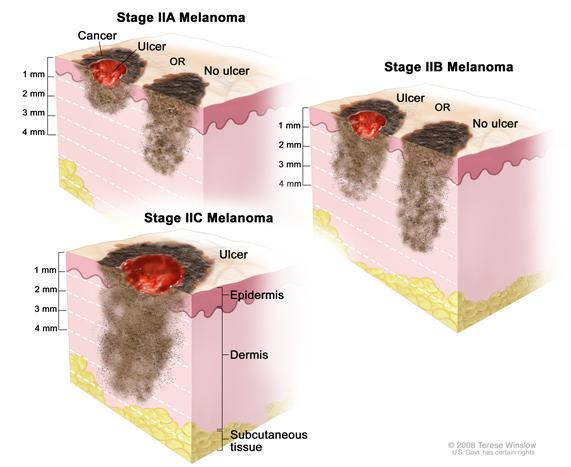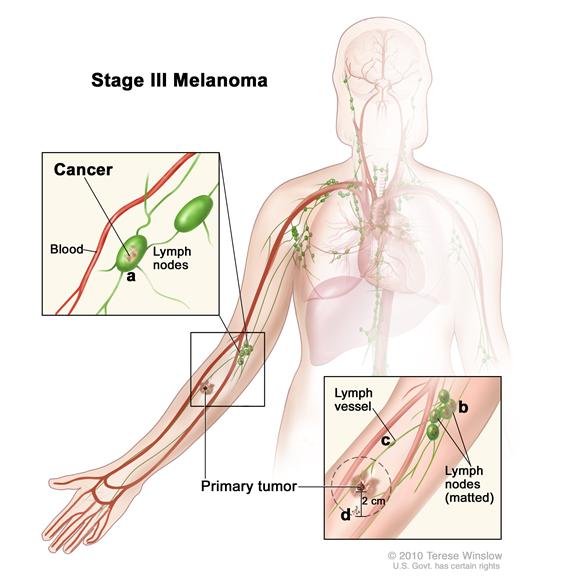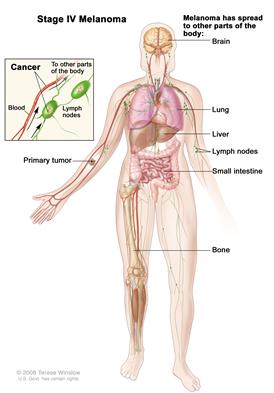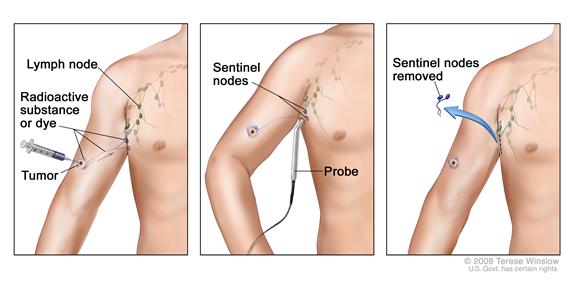MELANOMA LEVELS OR STAGES
General Information About Melanoma
| Key Points for This Section |
 |
- Melanoma is a disease in which malignant (cancer) cells form in the skin cells called melanocytes (cells that color the skin).
- Melanoma can occur anywhere on the body.
- Unusual moles, exposure to sunlight, and health history can affect the risk of developing melanoma.
- Possible signs of melanoma include a change in the appearance of a mole or pigmented area.
- Tests that examine the skin are used to detect (find) and diagnose melanoma.
- Certain factors affect prognosis (chance of recovery) and treatment options
Melanoma is a disease in which malignant (cancer) cells form in the skin cells called melanocytes (cells that color the skin).
Melanocytes are found throughout the lower part of the epidermis. They make melanin, the pigment that gives skin its natural color. When skin is exposed to the sun, melanocytes make more pigment, causing the skin to tan, or darken.
| Enlarge |
 |
| Anatomy of the skin, showing the epidermis, dermis, and subcutaneous tissue. Melanocytes are in the layer of basal cells at the deepest part of the epidermis. |
The skin is the body’s largest organ. It protects against heat, sunlight, injury, and infection. The skin has 2 main layers: the epidermis (upper or outer layer) and the dermis (lower or inner layer).
When melanoma starts in the skin, the disease is called cutaneous melanoma. This PDQ summary is about cutaneous (skin) melanoma. Melanoma may also occur in the eye and is called intraocular or ocular melanoma. (See the PDQ summary on Intraocular (Eye) Melanoma Treatment for more information.)
There are 3 types of skin cancer:
- Melanoma.
- Basal cell skin cancer.
- Squamous cell skin cancer.
Melanoma is more aggressive than basal cell skin cancer or squamous cell skin cancer. (See the PDQ summary on Skin Cancer Treatment for more information on basal cell and squamous cell skin cancer.)
Melanoma can occur anywhere on the body.
In men, melanoma is often found on the trunk (the area from the shoulders to the hips) or the head and neck. In women, melanoma often develops on the arms and legs. Melanoma usually occurs in adults, but it is sometimes found in children and adolescents.
Unusual moles, exposure to sunlight, and health history can affect the risk of developing melanoma.
Anything that increases your risk of getting a disease is called a risk factor. Having a risk factor does not mean that you will get cancer; not having risk factors doesn’t mean that you will not get cancer. People who think they may be at risk should discuss this with their doctor. Risk factors for melanoma include the following:
- Having a fair complexion, which includes the following:
- Being exposed to natural sunlight or artificial sunlight (such as from tanning beds) over long periods of time.
- Having a history of many blistering sunburns as a child.
- Having several large or many small moles.
- Having a family history of unusual moles (atypical nevus syndrome).
- Having a family or personal history of melanoma.
- Being white and male.
Possible signs of melanoma include a change in the appearance of a mole or pigmented area.
These and other symptoms may be caused by melanoma. Other conditions may cause the same symptoms. A doctor should be consulted if any of the following problems occur:
- A mole that:
- changes in size, shape, or color.
- has irregular edges or borders.
- is more than 1 color.
- is asymmetrical (if the mole is divided in half, the 2 halves are different in size or shape).
- itches.
- oozes, bleeds, or is ulcerated (a hole forms in the skin when the top layer of cells breaks down and the tissue below shows through).
- Change in pigmented (colored) skin.
- Satellite moles (new moles that grow near an existing mole).
Tests that examine the skin are used to detect (find) and diagnose melanoma.
If a mole or pigmented area of the skin changes or looks abnormal, the following tests and procedures can help detect and diagnose melanoma:
- Skin examination: A doctor or nurse checks the skin for moles, birthmarks, or other pigmented areas that look abnormal in color, size, shape, or texture.
- Biopsy: A local excision is done to remove as much of the suspicious mole or lesion as possible. A pathologist then looks at the tissue under a microscope to check for cancer cells. Because melanoma can be hard to diagnose, patients should consider having their biopsy sample checked by a second pathologist.
Suspicious areas of the skin should be biopsied and not be shaved off or cauterized (destroyed with a hot instrument, an electrical current, or a caustic substance).
Certain factors affect prognosis (chance of recovery) and treatment options.
The prognosis (chance of recovery) and treatment options depend on the following:
- The thickness of the tumor and where it is in the body.
- How quickly the cancer cells are dividing.
- Whether there was bleeding or ulceration at the primary site.
- Whether cancer has spread to the lymph nodes or to other places in the body.
- The number of places cancer has spread to in the body and the level of lactate dehyrogenase (LDH) in the blood.
- The patient’s general health.
Although many people are successfully treated, melanoma can recur (come back).
| Key Points for This Section |
 |
- After melanoma has been diagnosed, tests are done to find out if cancer cells have spread within the skin or to other parts of the body.
- There are three ways that cancer spreads in the body.
- The Clark levels are used for thin tumors to describe how deeply the cancer has spread into the different layers of the skin:
- Level I
- Level II
- Level III
- Level IV
- Level V
- The following stages are used for melanoma:
- Stage 0 (Melanoma in Situ)
- Stage I
- Stage II
- Stage III
- Stage IV

After melanoma has been diagnosed, tests are done to find out if cancer cells have spread within the skin or to other parts of the body.
The process used to find out whether cancer has spread within the skin or to other parts of the body is called staging. The information gathered from the staging process determines the stage of the disease. It is important to know the stage in order to plan treatment. Talk with your doctor about what the stage of your cancer is.
The following tests and procedures may be used in the staging process:
- Wide local excision: A surgical procedure to remove some of the normal tissue surrounding the area where melanoma was found, to check for cancer cells.
- Lymph node mapping and sentinel lymph node biopsy: Procedures in which a radioactive substance and/or blue dye is injected near the tumor. The substance or dye flows through lymph ducts to the sentinel node or nodes (the first lymph node or nodes where cancer cells are likely to have spread). The surgeon removes only the nodes with the radioactive substance or dye. A pathologist then checks the sentinel lymph nodes for cancer cells. If no cancer cells are detected, it may not be necessary to remove additional nodes.
- Chest x-ray: An x-ray of the organs and bones inside the chest. An x-ray is a type of energy beam that can go through the body and onto film, making a picture of areas inside the body.
- CT scan (CAT scan): A procedure that makes a series of detailed pictures of areas inside the body, taken from different angles. The pictures are made by a computer linked to an x-ray machine. A dye may be injected into a vein or swallowed to help the organs or tissues show up more clearly. This procedure is also called computed tomography, computerized tomography, or computerized axial tomography. For melanoma, pictures may be taken of the chest, abdomen, and pelvis.
- MRI (magnetic resonance imaging): A procedure that uses a magnet, radio waves, and a computer to make a series of detailed pictures of areas inside the body. This procedure is also called nuclear magnetic resonance imaging (NMRI).
- PET scan (positron emission tomography scan): A procedure to find malignant tumor cells in the body. A small amount of radioactive glucose (sugar) is injected into a vein. The PET scanner rotates around the body and makes a picture of where glucose is being used in the body. Malignant tumor cells show up brighter in the picture because they are more active and take up more glucose than normal cells do.
- Laboratory tests: Medical procedures that test samples of tissue, blood, urine, or other substances in the body. These tests help to diagnose disease, plan and check treatment, or monitor the disease over time.
- Blood chemistry studies: A procedure in which a blood sample is checked to measure the amounts of certain substances released into the blood by organs and tissues in the body. For melanoma, the blood is checked for an enzyme called lactate dehydrogenase (LDH).
The results of these tests are viewed together with the results of the tumor biopsy to determine the melanoma stage.
There are three ways that cancer spreads in the body.
The three ways that cancer spreads in the body are:
- Through tissue. Cancer invades the surrounding normal tissue.
- Through the lymph system. Cancer invades the lymph system and travels through the lymph vessels to other places in the body.
- Through the blood. Cancer invades the veins and capillaries and travels through the blood to other places in the body.
When cancer cells break away from the primary (original) tumor and travel through the lymph or blood to other places in the body, another (secondary) tumor may form. This process is called metastasis. The secondary (metastatic) tumor is the same type of cancer as the primary tumor. For example, if breast cancer spreads to the bones, the cancer cells in the bones are actually breast cancer cells. The disease is metastatic breast cancer, not bone cancer.
The Clark levels are used for thin tumors to describe how deeply the cancer has spread into the different layers of the skin:
| Enlarge |
 |
| Clark levels of melanoma. In Clark Level I, the cancer is in the epidermis only. In Clark Level II, the cancer has begun to spread into the papillary dermis (upper layer of the dermis). In Clark Level III, the cancer has spread through the papillary dermis into the papillary-reticular dermal interface but not into the reticular dermis (lower layer of the dermis). In Clark Level IV, the cancer has spread into the reticular dermis. In Clark Level V, the cancer has spread into the subcutaneous tissue. |
Level I
The cancer is in the epidermis only.
Level II
The cancer has begun to spread into the papillary dermis (upper layer of the dermis).
Level III
The cancer has spread through the papillary dermis (upper layer of the dermis) into the papillary-reticular dermal interface (the layer between the papillary dermis and the reticular dermis).
Level IV
The cancer has spread into the reticular dermis (lower layer of the dermis).
Level V
The cancer has spread into the subcutaneous layer (below the skin).
The following stages are used for melanoma:
| Enlarge |
 |
| Stage 0 melanoma. Abnormal melanocytes are in the epidermis (outer layer of the skin). |
In stage 0, abnormal melanocytes are found in the epidermis. These abnormal melanocytes may become cancer and spread into nearby normal tissue. Stage 0 is also called melanoma in situ.
| Enlarge |
 |
| Millimeters (mm). A sharp pencil point is about 1 mm, a new crayon point is about 2 mm, and a new pencil eraser is about 5 mm. |
| Enlarge |
 |
| Stage I melanoma. In stage IA, the tumor is not more than 1 millimeter thick, with no ulceration (break in the skin). In stage IB, the tumor is either not more than 1 millimeter thick, with ulceration, OR more than 1 but not more than 2 millimeters thick, with no ulceration. Skin thickness is different on different parts of the body. |
In stage I, cancer has formed. Stage I is divided into stages IA and IB.
- Stage IA: In stage IA, the tumor is not more than 1 millimeter thick, with no ulceration.
- Stage IB: In stage IB, the tumor is either:
- not more than 1 millimeter thick and it has ulceration; or
- more than 1 but not more than 2 millimeters thick, with no ulceration.
| Enlarge |
 |
| Stage II melanoma. In stage IIA, the tumor is either more than 1 but not more than 2 millimeters thick, with ulceration (break in the skin), OR it is more than 2 but not more than 4 millimeters thick, with no ulceration. In stage IIB, the tumor is either more than 2 but not more than 4 millimeters thick, with ulceration, OR it is more than 4 millimeters thick, with no ulceration. In stage IIC, the tumor is more than 4 millimeters thick, with ulceration. Skin thickness is different on different parts of the body. |
Stage II is divided into stages IIA, IIB, and IIC.
- Stage IIA: In stage IIA, the tumor is either:
- more than 1 but not more than 2 millimeters thick, with ulceration; or
- more than 2 but not more than 4 millimeters thick, with no ulceration.
- Stage IIB: In stage IIB, the tumor is either:
- more than 2 but not more than 4 millimeters thick, with ulceration; or
- more than 4 millimeters thick, with no ulceration.
- Stage IIC: In stage IIC, the tumor is more than 4 millimeters thick, with ulceration.
Stage III
| Enlarge |
 |
| Stage III melanoma. The tumor may be any thickness with or without ulceration. It has spread either (a) into a nearby lymph vessel and may have spread to nearby lymph nodes; OR (b) to 1 or more lymph nodes, which may be matted (not moveable). Skin thickness is different on different parts of the body. |
In stage III, the tumor may be any thickness, with or without ulceration. One or more of the following is true:
- Cancer has spread to one or more lymph nodes.
- Lymph nodes may be joined together (matted).
- Cancer may be in a lymph vessel between the primary tumor and nearby lymph nodes.
- Very small tumors may be found on or under the skin, not more than 2 centimeters away from where the cancer first started.
| Enlarge |
 |
| Stage IV melanoma. The tumor has spread to other parts of the body. |
In stage IV, the cancer has spread to other places in the body, such as the lung, liver, brain, bone, soft tissue, or gastrointestinal (GI) tract. Cancer may also spread to places in the skin far away from where the cancer first started.
 Back to Top
Back to Top
Recurrent Melanoma
Recurrent melanoma is cancer that has recurred (come back) after it has been treated. The cancer may come back in the original site or in other parts of the body, such as the lungs or liver.
 Back to Top
Back to Top
| Key Points for This Section |
 |
- There are different types of treatment for patients with melanoma.
- Four types of standard treatment are used:
- Surgery
- Chemotherapy
- Radiation therapy
- Biologic therapy
- New types of treatment are being tested in clinical trials.
- Chemoimmunotherapy
- Targeted therapy
- Vaccine therapy
- Patients may want to think about taking part in a clinical trial.
- Patients can enter clinical trials before, during, or after starting their cancer treatment.
- Follow-up tests may be needed.

There are different types of treatment for patients with melanoma.
Different types of treatment are available for patients with melanoma. Some treatments are standard (the currently used treatment), and some are being tested in clinical trials. A treatment clinical trial is a research study meant to help improve current treatments or obtain information on new treatments for patients with cancer. When clinical trials show that a new treatment is better than the standard treatment, the new treatment may become the standard treatment. Patients may want to think about taking part in a clinical trial. Some clinical trials are open only to patients who have not started treatment.
Four types of standard treatment are used:
Surgery
Surgery to remove the tumor is the primary treatment of all stages of melanoma. The doctor may remove the tumor using the following operations:
- Local excision: Taking out the melanoma and some of the normal tissue around it.
- Wide local excision with or without removal of lymph nodes.
- Lymphadenectomy: A surgical procedure in which the lymph nodes are removed and examined to see whether they contain cancer.
- Sentinel lymph node biopsy: The removal of the sentinel lymph node (the first lymph node the cancer is likely to spread to from the tumor) during surgery. A radioactive substance and/or blue dye is injected near the tumor. The substance or dye flows through the lymph ducts to the lymph nodes. The first lymph node to receive the substance or dye is removed for biopsy. A pathologist views the tissue under a microscope to look for cancer cells. If cancer cells are not found, it may not be necessary to remove more lymph nodes.
Enlarge 
Sentinel lymph node biopsy of the skin. A radioactive substance and/or blue dye is injected near the tumor (first panel). The injected material is detected visually and/or with a probe that detects radioactivity (middle panel). The sentinel nodes (the first lymph nodes to take up the material) are removed and checked for cancer cells (last panel).
Skin grafting (taking skin from another part of the body to replace the skin that is removed) may be done to cover the wound caused by surgery.
Even if the doctor removes all the melanoma that can be seen at the time of the operation, some patients may be offered chemotherapy after surgery to kill any cancer cells that are left. Chemotherapy given after surgery, to lower the risk that the cancer will come back, is called adjuvant therapy.
Chemotherapy
Chemotherapy is a cancer treatment that uses drugs to stop the growth of cancer cells, either by killing the cells or by stopping them from dividing. When chemotherapy is taken by mouth or injected into a vein or muscle, the drugs enter the bloodstream and can reach cancer cells throughout the body (systemic chemotherapy). When chemotherapy is placed directly into the cerebrospinal fluid, an organ, or a body cavity such as the abdomen, the drugs mainly affect cancer cells in those areas (regional chemotherapy).
In treating melanoma, anticancer drugs may be given as a hyperthermic isolated limb perfusion. This technique sends anticancer drugs directly to the arm or leg in which the cancer is located. The flow of blood to and from the limb is temporarily stopped with a tourniquet, and a warm solution containing anticancer drugs is put directly into the blood of the limb. This allows the patient to receive a high dose of drugs in the area where the cancer occurred.
The way the chemotherapy is given depends on the type and stage of the cancer being treated.
Radiation therapy
Radiation therapy is a cancer treatment that uses high-energy x-rays or other types of radiation to kill cancer cells or keep them from growing. There are two types of radiation therapy. External radiation therapy uses a machine outside the body to send radiation toward the cancer. Internal radiation therapy uses a radioactive substance sealed in needles, seeds, wires, or catheters that are placed directly into or near the cancer. The way the radiation therapy is given depends on the type and stage of the cancer being treated.
Biologic therapy
Biologic therapy is a treatment that uses the patient’s immune system to fight cancer. Substances made by the body or made in a laboratory are used to boost, direct, or restore the body’s natural defenses against cancer. This type of cancer treatment is also called biotherapy or immunotherapy.
New types of treatment are being tested in clinical trials.
This summary section describes treatments that are being studied in clinical trials. It may not mention every new treatment being studied. Information about clinical trials is available from the NCI Web site
Chemoimmunotherapy
Chemoimmunotherapy is the use of anticancer drugs combined with biologic therapy to boost the immune system to kill cancer cells.
Targeted therapy
Targeted therapy is a type of treatment that uses drugs or other substances to identify and attack specific cancer cells without harming normal cells. Monoclonal antibody therapy is a type of targeted therapy being studied in the treatment of melanoma.
Monoclonal antibody therapy is a cancer treatment that uses antibodies made in the laboratory, from a single type of immune system cell. These antibodies can identify substances on cancer cells or normal substances that may help cancer cells grow. The antibodies attach to the substances and kill the cancer cells, block their growth, or keep them from spreading. Monoclonal antibodies are given by infusion. They may be used alone or to carry drugs, toxins, or radioactive material directly to cancer cells. Monoclonal antibodies may be used in combination with chemotherapy as adjuvant therapy.
Vaccine therapy
Vaccine therapy is a type of biologic therapy. Cancer vaccines work by helping the immune system recognize and attack specific types of cancer cells. Vaccine therapy can also be a type of targeted therapy.
Patients may want to think about taking part in a clinical trial.
For some patients, taking part in a clinical trial may be the best treatment choice. Clinical trials are part of the cancer research process. Clinical trials are done to find out if new cancer treatments are safe and effective or better than the standard treatment.
Many of today’s standard treatments for cancer are based on earlier clinical trials. Patients who take part in a clinical trial may receive the standard treatment or be among the first to receive a new treatment.
Patients who take part in clinical trials also help improve the way cancer will be treated in the future. Even when clinical trials do not lead to effective new treatments, they often answer important questions and help move research forward.
Patients can enter clinical trials before, during, or after starting their cancer treatment.
Some clinical trials only include patients who have not yet received treatment. Other trials test treatments for patients whose cancer has not gotten better. There are also clinical trials that test new ways to stop cancer from recurring (coming back) or reduce the side effects of cancer treatment.
Clinical trials are taking place in many parts of the country. See the Treatment Options section that follows for links to current treatment clinical trials. These have been retrieved from NCI’s listing of clinical trials.
Follow-up tests may be needed.
Some of the tests that were done to diagnose the cancer or to find out the stage of the cancer may be repeated. Some tests will be repeated in order to see how well the treatment is working. Decisions about whether to continue, change, or stop treatment may be based on the results of these tests. This is sometimes called re-staging.
Some of the tests will continue to be done from time to time after treatment has ended. The results of these tests can show if your condition has changed or if the cancer has recurred (come back). These tests are sometimes called follow-up tests or check-ups.
 Back to Top
Back to Top
Treatment Options by Stage
A link to a list of current clinical trials is included for each treatment section. For some types or stages of cancer, there may not be any trials listed. Check with your doctor for clinical trials that are not listed here but may be right for you.
Stage 0 (Melanoma in Situ)Treatment of stage 0 is usually surgery to remove the area of abnormal cells and a small amount of normal tissue around it.
Check for U.S. clinical trials from NCI’s PDQ Cancer Clinical Trials Registry that are now accepting patients with stage 0 melanoma. For more specific results, refine the search by using other search features, such as the location of the trial, the type of treatment, or the name of the drug. General information about clinical trials is available from the NCI Web site.
Stage I MelanomaTreatment of stage I melanoma may include the following:
- Surgery to remove the tumor and some of the normal tissue around it.
- A clinical trial of surgery to remove the tumor and some of the normal tissue around it, with or without lymph node mapping and lymphadenectomy.
- A clinical trial of new techniques to detect cancer cells in the lymph nodes.
- A clinical trial of lymphadenectomy with or without adjuvant therapy.
Check for U.S. clinical trials from NCI’s PDQ Cancer Clinical Trials Registry that are now accepting patients with stage I melanoma. For more specific results, refine the search by using other search features, such as the location of the trial, the type of treatment, or the name of the drug. General information about clinical trials is available from the NCI Web site.
Stage II MelanomaTreatment of stage II melanoma may include the following:
- Surgery to remove the tumor and some of the normal tissue around it, followed by removal of nearby lymph nodes.
- Lymph node mapping and sentinel lymph node biopsy, followed by surgery to remove the tumor and some of the normal tissue around it. If cancer is found in the sentinel lymph node, a second surgery may be done to remove more nearby lymph nodes.
- Surgery followed by high- dose biologic therapy.
- A clinical trial of adjuvant chemotherapy and/or biologic therapy.
- A clinical trial of new techniques to detect cancer cells in the lymph nodes.
Check for U.S. clinical trials from NCI’s PDQ Cancer Clinical Trials Registry that are now accepting patients with stage II melanoma. For more specific results, refine the search by using other search features, such as the location of the trial, the type of treatment, or the name of the drug. General information about clinical trials is available from the NCI Web site.
Stage III MelanomaTreatment of stage III melanoma may include the following:
- Surgery to remove the tumor and some of the normal tissue around it.
- Surgery to remove the tumor with skin grafting to cover the wound caused by surgery.
- Surgery followed by biologic therapy.
- A clinical trial of surgery followed by chemotherapy and/or biologic therapy.
- A clinical trial of biologic therapy.
- A clinical trial comparing surgery alone to surgery with biologic therapy.
- A clinical trial of chemoimmunotherapy or biologic therapy.
- A clinical trial of hyperthermic isolated limb perfusion using chemotherapy and biologic therapy.
- A clinical trial of biologic therapy and radiation therapy.
Check for U.S. clinical trials from NCI’s PDQ Cancer Clinical Trials Registry that are now accepting patients with stage III melanoma. For more specific results, refine the search by using other search features, such as the location of the trial, the type of treatment, or the name of the drug. General information about clinical trials is available from the NCI Web site.
Stage IV MelanomaTreatment of stage IV melanoma may include the following:
- Surgery or radiation therapy as palliative therapy to relieve symptoms and improve quality of life.
- Chemotherapy and/or biologic therapy.
- A clinical trial of new chemotherapy, biologic therapy, and/or targeted therapy with monoclonal antibodies, or vaccine therapy.
- A clinical trial of radiation therapy as palliative therapy to relieve symptoms and improve quality of life.
- A clinical trial of surgery to remove all known cancer.
Check for U.S. clinical trials from NCI’s PDQ Cancer Clinical Trials Registry that are now accepting patients with stage IV melanoma. For more specific results, refine the search by using other search features, such as the location of the trial, the type of treatment, or the name of the drug. General information about clinical trials is available from the NCI Web site.
 Back to Top
Back to Top
Treatment Options for Recurrent Melanoma
Treatment of recurrent melanoma may include the following:
- Surgery to remove the tumor.
- Hyperthermic isolated limb perfusion.
- Radiation therapy as palliative therapy to relieve symptoms and improve quality of life.
- Palliative treatment with biologic therapy.
- A clinical trial of biologic therapy and/or chemotherapy as palliative therapy to relieve symptoms and improve quality of life.
Check for U.S. clinical trials from NCI’s PDQ Cancer Clinical Trials Registry that are now accepting patients with recurrent melanoma. For more specific results, refine the search by using other search features, such as the location of the trial, the type of treatment, or the name of the drug. General information about clinical trials is available from the NCI Web site.
